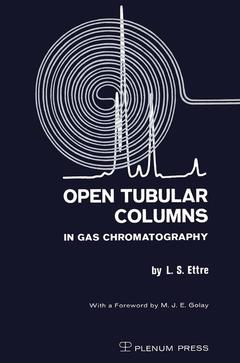Open Tubular Columns in Gas Chromatography, Softcover reprint of the original 1st ed. 1965
Langue : Anglais
Auteur : Ettre Leslie S.

For my past sins, Leslie Ettre has given me the privilege of writing a few words to preface his excellent little book. It gives me great pleasure to do so, because of the many years of fruitful collabo ration we have had at Perkin-Elmer, because it is refreshing to see a treatise in gas chromatography in which the theoretical treatment has been bared to its essentials, without a mushrooming of formulae which, by means of an ever increasing number of parameters, account for more and more, and explain less and less, and because the author has recognized that the gas chromatographic column is a nearly passive element in its own right which deserves to have a treatise written nearly exclusively about it, just as electrical circuit theory can be discussed without elaborate references to vacuum tubes and meters. I wish this conscientiously written volume the success it deserves. M. J. E. GOLAY VII Preface Gas chromatography is a separation technique used primarily in analytical chemistry. Therefore, it is evident that special emphasis should be placed on that particular part of the apparatus in which the separation takes place. This part is the column, the heart of the gas chromatograph. The goal of researchers in the field of gas chromatography has been-from the beginning-to understand the separation process so that they might design columns with the best possible performance. Such investigation led M. J. E.
First Part. Introduction.- 1.1 Origins.- 1.2 Nomenclature.- 1.3 Terms and Definitions.- 1.31 Characterization of a Peak.- 1.32 The Partition Process.- 1.33 Peak Separation.- 1.34 Column Efficiency.- 1.35 Flow Rate and Gas Velocity.- Second Part. Theory and Practice.- 2.1 The Basic Golay Equation.- 2.2 Practical Conclusions from the Golay Equation.- 2.21 Column Efficiency.- 2.22 Carrier Gas Flow.- 2.23 Selection of Carrier Gas.- 2.24 Liquid-Film Thickness.- 2.3 Comparison with Packed Columns.- 2.31 Influence of the ? Values on Column Characteristics.- 2.32 Changes in the Necessary Column Efficiency.- 2.321 Number of Theoretical Plates Required at Various ? and k Values.- 2.322 Comparison of the Two Column Types.- 2.323 Examples.- 2.323.1 Analysis of p/m-Xylenes.- 2.323.2 Analysis of Fatty Acid Methyl Esters.- 2.33 Influence of Column Permeability.- 2.331 Specific Permeability.- 2.332 Correlation Between Specific Permeability and Pressure Drop Through the Column.- 2.333 Comparison of Practical Columns.- 2.34 The Performance Index.- 2.35 Modified Expressions Related to the Plate Number Concept.- 2.351 Number of Effective Plates.- 2.352 Height Equivalent to One Effective Plate.- 2.353 Modified Expression for the Number of Theoretical Plates.- 2.354 Resolution Factor.- 2.36 Practical Applications.- 2.4 The Influence of Temperature.- 2.5 Sample Capacity.- 2.6 Open Tubular Columns of Various Diameters.- Third Part. Preparation of Open Tubular Columns.- 3.1 Tubing.- 3.11 Plastic Tubing.- 3.12 Glass Tubing.- 3.13 Metal Tubing.- 3.2 Coating of the Column Tubing.- 3.21 Cleaning of the Column Tubing.- 3.22 Dynamic Coating Method.- 3.221 Volume of Coating Solution Larger Than the Volume of Tubing.- 3.222 Plug Method.- 3.23 Static Coating Method.- 3.24 Elimination of the Secondary Adsorption Effects of Column Tubing.- 3.25 Column Conditioning and Storage.- 3.26 Recoating of Open Tubular Columns.- 3.3 Testing of Open Tubular Columns.- 3.31 The Use of the “Polarity Mixture” for Testing.- 3.32 Determination of the “Air Peak” Time.- 3.4 Increase of the Inside Surface Area of the Column Tubing.- 3.41 Chemical Treatment of the Inside Wall of the Tubing.- 3.42 Deposition of a Porous Support Layer on the Inside Wall of the Tubing.- 3.5 Adsorption-Type Open Tubular Columns.- 3.51 Plating Methods.- 3.52 Adsorption Columns with Chemically Modified Inside Wall.- 3.53 Open Tubular Columns Coated with an Adsorptive Layer.- 3.54 Modification of the Van Deemter—Golay Equation for Open Tubular Adsorption Columns.- Fourth Part. The Gas Chromatographic System.- 4.1 Sample Introduction.- 4.11 Sample Introduction Systems.- 4.12 Split Systems.- 4.121 Dynamic Splitting.- 4.122 Static Splitting.- 4.2 The Pneumatic System.- 4.21 Carrier Gas Regulation.- 4.22 Connecting Tubes.- 4.3 Column Heating.- 4.31 Isothermal Operation.- 4.32 Programmed-Temperature Operation.- 4.33 Applications of Temperature-Programmed Open Tubular Columns.- 4.34 Compensation of Liquid-Phase Bleeding During Temperature Programming.- 4.4 Detection and Recording.- 4.41 Commonly Used Detectors.- 4.42 Auxiliary Detectors.- 4.43 Recording Systems.- Fifth Part. Bibliography.- Sixth Part. Supplements.- 6.1 Calculation of the “Air Peak” Time.- 6.11 The Method of Peterson and Hirsch.- 6.12 The Method of Gold.- 6.2 Instrumentation.
Date de parution : 02-2012
Ouvrage de 164 p.
15.2x22.9 cm
Disponible chez l'éditeur (délai d'approvisionnement : 15 jours).
Prix indicatif 52,74 €
Ajouter au panierThème d’Open Tubular Columns in Gas Chromatography :
Mots-clés :
Sorption; adsorption; analytical chemistry; chemistry; chromatography; element; metals
© 2024 LAVOISIER S.A.S.



